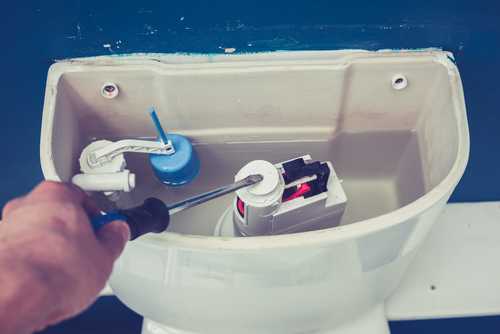Toilets are an essential part of our daily lives, and when they encounter issues, it can be frustrating. However, many common toilet problems can be resolved easily with a little know-how and some basic tools. In this comprehensive guide, we will explore various toilet problems and provide you with step-by-step instructions on how to fix them. So, let’s dive in and tackle these pesky toilet issues together!
1. Clogged Toilet
Few things are more inconvenient than a clogged toilet. It can lead to overflowing and potential water damage if not addressed promptly. To fix a clogged toilet, follow these steps:
- Start by using a plunger. Position it over the drain hole and push down gently but firmly. Then, rapidly plunge up and down to create suction. Repeat several times until the water starts to drain.
- If plunging doesn’t work, try using a toilet auger. Insert the auger into the drain and crank the handle clockwise. Continue cranking until you feel resistance or the clog clears.
- For stubborn clogs, a toilet snake might be necessary. Insert the snake into the drain and rotate it while applying gentle pressure. This helps break up the clog and clear the blockage.
2. Weak Flushing
Is your toilet not flushing with the usual power? A weak flushing toilet can be inconvenient and may require some adjustments. Follow these steps to address the issue:
- Check the water level in the tank. It should be approximately one inch below the overflow tube. Adjust the float mechanism or the fill valve if needed.
- Examine the flush holes under the toilet rim. If they are clogged, use a small mirror and a wire hanger to gently remove any mineral deposits or debris.
- Ensure that the flapper is opening fully when you flush. If it’s not, adjust the chain length or replace the flapper if it’s damaged.
3. Constantly Running Toilet
A constantly running toilet can waste a significant amount of water, leading to higher bills and environmental concerns. Here’s how you can troubleshoot and fix this issue:
- Check the flapper valve. If it’s not sealing properly, water will continuously flow into the toilet bowl. Adjust or replace the flapper as necessary.
- Inspect the fill valve and float. If the float is set too high, the water level will rise above the overflow tube, causing the toilet to run continuously. Adjust the float arm or replace the fill valve if needed.
- Look for any leaks in the flush valve or the refill tube. If you notice any water escaping, replace the faulty parts.
4. Leaky Toilet
A leaky toilet can waste water and damage your bathroom floor. Don’t ignore even small leaks, as they can lead to bigger problems. Follow these steps to fix a leaky toilet:
- Check the water supply line and the connections. Tighten any loose fittings, but be careful not to overtighten and cause damage.
- Examine the bolts and washers at the base of the toilet. If they are worn or loose, tighten them or replace them if necessary.
- Inspect the wax ring seal between the toilet and the floor. If it’s damaged, water can leak around the base. Turn off the water supply, drain the toilet, and replace the wax ring.
5. Phantom Flushes
Do you ever hear your toilet flushing by itself? These phantom flushes occur due to a slow leak from the tank to the bowl. To fix this problem, follow these steps:
- Check the flapper for any signs of damage or debris. Clean it thoroughly and ensure it seals tightly.
- Inspect the flapper chain and adjust its length if needed. It should have a slight slack to allow proper closure without preventing a complete seal.
- If the flapper appears to be in good condition, consider replacing the fill valve. A faulty fill valve can cause water to slowly leak into the bowl, triggering phantom flushes.
Conclusion
Dealing with common toilet problems doesn’t have to be a daunting task. By following the step-by-step instructions provided in this guide, you can troubleshoot and fix many toilet issues on your own. Remember, it’s essential to address these problems promptly to prevent further damage and ensure the efficient functioning of your toilet.
FAQs
- Q: Can I use chemical drain cleaners to unclog my toilet? A: It’s generally not recommended to use chemical drain cleaners for toilets. They can damage the plumbing system and cause more harm than good. It’s best to use a plunger, toilet auger, or snake to clear the clog manually.
- Q: Why is my toilet making gurgling sounds? A: Gurgling sounds in the toilet usually indicate a clog or blockage in the drain pipes. It’s important to address this issue promptly to prevent further plumbing problems. Try using a plunger or an auger to clear the blockage.
- Q: How can I prevent my toilet from running continuously? A: To prevent a continuously running toilet, make sure the flapper is sealing properly. Check the float and adjust it to the correct water level. Regularly inspect the toilet’s internal components for any signs of wear or damage.
- Q: Why does my toilet smell bad even after cleaning? A: A persistent bad odor in the toilet could be due to a faulty wax ring seal or a clog in the plumbing vents. Inspect the wax ring for any damage and replace it if necessary. If the problem persists, it’s advisable to consult a plumber.
- Q: Can I fix a leaky toilet myself? A: Yes, you can fix a leaky toilet yourself by following the instructions provided in this guide. However, if you’re unsure or uncomfortable with plumbing tasks, it’s always best to seek professional help to avoid potential damage.




